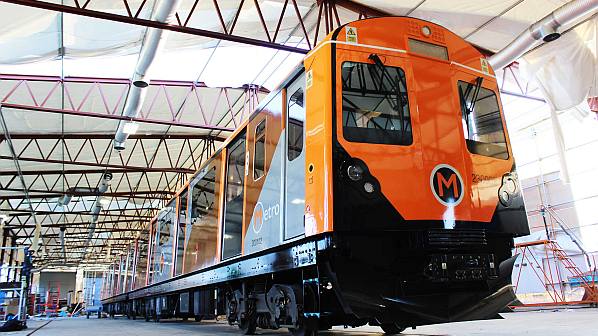A D-Train produced by Vivarail, Britain, is running in central Pennsylvania as the company seeks to demonstrate its Pop-Up Metro offer to the United States.
The two-car battery train was shipped to Baltimore in April and taken by road to a tramway museum, where it is being used to showcase the rebuilt former London Underground train and what it can offer the United States. It began operating in July with the delay caused by the travel restrictions as a result of the pandemic.
Speaking exclusively to IRJ at the Railtex/Infrarail trade event in Birmingham, Britain, on September 7, Mr Henry Posner III, chairman of Railroad Development Corporation, which is a shareholder in Vivarail, explains: “the location was selected because it's near two things. One, the people who are behind the project, and two, for many of the target markets and decision makers it’s within a three-hour trip by car from Washington DC, New York, or Pittsburgh. So it’s well positioned in terms of being in a location where you can demonstrate the train and without interfering with somebody else’s operation.”
Posner says urbanisation is key for the development of the train’s use in the United States. “Take The High Line in New York City. A non-operating freight rail line whose tragic flaw was that it was worth more dead than alive. So how can you preserve the footprint of the railway and put some of that value back in and then look at what that has meant?”
He says examples of real estate development as a major component of the evolution of rail in Britain and Japan has been studied, and that is where the D-Train fits into the plans. “If we could bring a D-Train train to the USA, under temporal separation but hold the opportunity out as a lease basis so that at different locations, you could prove the concept and the market.”
This, he says, would have two effects. The first would be reducing the risk of any project while the second would be to reduce the time taken to implement a project because “to build out a gold-plated, from scratch system, is always longer than a political cycle.”
Posner told IRJ that the plans involve underutilised railways and obtaining funding from either the public or private sector when developing plans, but that: “the overall goal is to make the pie for rail projects bigger by proving the market.” He says the aim is to prove the demand and then: “there might well be a case to go back and completely rebuild the railway, with brand new trains, etc. But it’s an intermediate step which we do not believe existed until we came up with the idea.
“What you want is to get something started and then see if it takes on a life of its own, either because there is overwhelming public demand, or, more likely, there is a single local champion either from the public sector or the private sector who can serve as a local partner or business model.
“I want RDC to partner with local interests because they usually have a lot more ideas than we do. As we talk about Pop-Up Metros with, for example, our friends and influencers in the rail industry, everybody’s got their favourite line that they think should be a slam dunk success.”
Trials
Posner was speaking to IRJ as videos of the class 230 D-Train operating in the tramway museum ran in the background. “People were not going to believe us until the train was there. All of a sudden, people are starting to pay attention and say, well, you really should be looking at this. One of the great things about the USA for something like this, is we’ve got all kinds of decentralisation in terms of decision making city-by-city. In each case, you're dealing with a different infrastructure owner, a different attitude toward transportation, a different transit authority, a different private sector. So what it provides is a highly diverse list of possibilities.
“As much as I'd like to think of it as being like the scene from the Field of Dreams, where the guy builds the baseball field and in the next scene there’s a line of vehicles coming over the horizon, this will more likely be relatively slow on the uptake, because people need to start being aware of it.”

